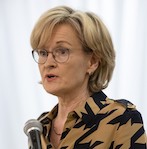
Supporting the transition to renewables: the role of the taxonomy
The EU is overly reliant on Russian gas and today Russia is using this reliance against us. It is trying to blackmail Europe, with Gazprom having cut off delivery to some EU member states. The commission has proposed a pathway for the EU – RePowerEU – to end our dependence on Russian energy and accelerate the move to a clean, secure, competitive and sustainable energy system. Ramping up green energy production and diversifying supplies is urgent. In an ideal world, we would make the switch to renewables and abandon fossil fuels immediately. But we are far from that place and there is a need, as we move more rapidly towards renewables, for some member states to continue to use gas and nuclear power in the medium term. These energy sources are essential for the transition to renewables in certain circumstances, particularly as there is an urgent need for countries to move from the dirtiest sources of energy like coal.
Ramping up the roll-out of renewable energy – wind, solar, hydro, hydrogen and so on – is the over-riding priority of the European Commission, on the road to climate neutrality by 2050.
This is what the European Green Deal is about.It is my responsibility as Commissioner for Financial Services to ensure that investment flows towards businesses and enterprises that match our climate ambitions, providing guidance to companies and financial institutions on the EU sustainable finance agenda. The EU taxonomy is a central part of this agenda, providing guidance to companies and investors about what is sustainable (green). It also provides guidance on what constitutes “transitional” and “enabling” technologies. The EU taxonomy is a voluntary tool to channel investments into sustainable activities. It does not mandate these investments, rather it provides clarity about what technologies are green, transitional or enabling. It is up to private investors to decide where they put their money. But if they want to align with the European Green Deal, their investments should be in line with the EU taxonomy.
Absolute priority
Renewable energies have absolute priority. The first list of sustainable economic activities that contribute to our climate goals – the so-called Climate Delegated Act, already in force since January 1st this year – includes 25 energy activities based on renewables. It also contains extensive energy efficiency measures and improvements to help reduce emissions in a wide range of sectors, such as building renovations and electric heat pumps. Only renewables qualify as sustainable under the taxonomy. Only renewables are green. These are and will continue to be the focus for green investors and green financial products. The commission has proposed that certain gas and nuclear activities, subject to strict conditions, are classified as “transitional” activities, providing a bridge away from the most polluting sources of energy like coal. In reality, we do not have enough capacity in renewables at present. Investment in gas and nuclear will continue for the time being. We believe strongly that it is better to limit and guide these investments in a way that will help the transition towards a more sustainable economy and society. The Complementary Delegated Act applies only if there is a full switch away from natural gas, and towards renewable and low-carbon gases. It is the only incentive of its kind in EU rules. We appreciate that including natural gas and nuclear in the EU taxonomy divides opinion. This reflects diverse views between and sometimes even within member states. However, the commission has proposed that where gas and nuclear are included in the taxonomy, clear conditions, in line with the EU’s climate targets and with strong safeguards against significant environmental harm, apply.
On gas, there are strict conditions including limits on emissions. Gas plants have to be efficient, and they qualify only where renewables are not available at sufficient scale.
And they must be fully committed to switch completely to renewable and low-carbon gases in the near future and by 2035 at the latest. Any gas plants must be built ready for such gases from the get-go – so no stranded assets. The criteria also require replacing high emitting coal plants and delivering clear emissions reductions. We need to move away from coal as a matter of urgency.
Climate neutrality
Our target is climate neutrality by 2050 and a reduction in emissions by 55 per cent by 2030. All our efforts go in this direction – incentivising the transition to a decarbonised energy system – with the extra and immediate challenge of cutting out Russian energy sources as soon as possible. We recognise that member states are at different starting points in decarbonising their energy mix.
We need to be in this together and help all member states on their transition towards climate neutrality, understanding that each faces a different set of challenges.
Ultimately, what matters is that all member states and the EU as a whole deliver on our collective climate ambition. Achieving this outcome requires pragmatism and political courage to point out the complexity of the process and the need for workable, real world solutions. The EU’s ambition is a low-carbon, sustainable future, powered by renewable energy and phasing out the most carbon-intensive energy sources like coal. We cannot get there by flicking a switch, and that may mean accepting pragmatic and managed solutions during the transition.




